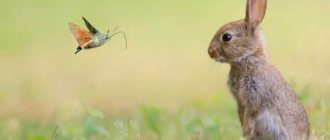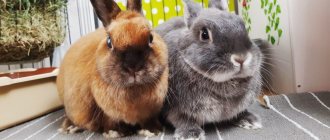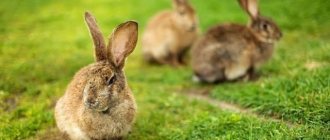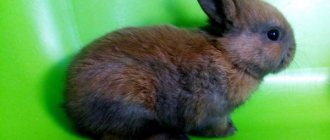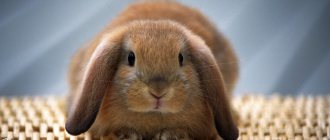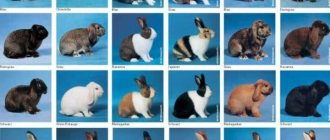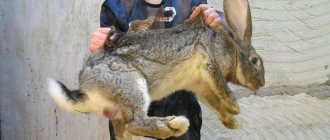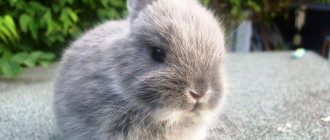Rabbits are wonderful animals; in the modern world they are more and more often kept as pets. They are easy to care for, have a calm disposition and are very affectionate. The dwarf lop-eared rabbit is no exception to this rule. His character is flexible, his disposition is meek, and his appearance is touchingly funny. The animal is small in size and weighs, depending on the pedigree and subspecies of the breed, from 1 to 3 kg, so the miniature eared one looks more like a soft toy than a living creature. The breed itself was bred relatively recently, in Holland, so it is only gaining popularity in Russia. Below we describe in detail about care, disease prevention measures and the characteristics of the lop-eared rabbit in general.
Origin
A dwarf species with erect ears was bred only in the middle of the 20th century, in Holland. The pets got their name from their hanging long ears and low body weight. Their calm character and sweet appearance quickly made them popular. In fact, this is a smaller copy of the classic fold-eared ram.
It was officially legalized in 1964, but rabbits were officially brought into Russia only in 1997. They came here from the USA and immediately became beloved pets and excellent friends for children. Read about keeping and caring for the Lop-eared sheep rabbit here.
The dwarf lop-eared rabbit was first bred in Holland
Diet of the fold sheep
Menu of decorative breed rabbits:
- root vegetables - carrots, boiled potatoes, turnips, pumpkin, raw broccoli; as well as Jerusalem artichoke, beets, zucchini;
- grains - peeled oats, wheat, sunflower seeds, flax, pumpkin;
- green food - in summer - fresh grass collected in an environmentally friendly place, in winter - dried herbs.
Fold-eared rams will like dandelions, plantain, clover, fireweed, reed, sorrel. For normal digestion, lop-eared rabbits need fiber, which is found in beans, corn, young apple, cherry, and apricot twigs.
A dangerous product for lop-eared sheep is white and red cabbage. The vegetable contains substances that stimulate the production of digestive enzymes. With regular consumption of cabbage, sheep rabbits suffer from intestinal bloating, and in severe cases, digestion stops. Instead of white cabbage, you can give cauliflower. Its inflorescences contain fiber, vitamins A, B and C.
Ready-made mixtures for rabbits consist of grains and seeds, and are suitable as roughage. Pellets contain hay, vegetable pieces and mineral supplements to improve the appearance of the coat. Hard granules wear down teeth.
Ready-made food is balanced and suitable for daily feeding. But lop-eared rabbits do not eat all components equally well; they choose the most attractive in smell and taste. As a result, the balance is disrupted. Therefore, for rams it is better to buy a grain mixture and add home-cooked vegetables.
Description of the breed
A distinctive feature of rabbits - hanging ears for other breeds (white New Zealand, Gray Giant) is a deviation, but for this one it is the norm.
- The animal's body is dense , the neck is shortened, and the head is set deep. Due to this, the pet appears in the shape of a small ball.
- The legs are short, the muscular system is well developed, so the animal’s legs are strong.
- The coat is shiny, with a dense down and very soft. The colors of the lop-eared rabbit vary, but the most common is red.
- Life expectancy is on average 7 years , but with proper care it can reach 10 years.
- Weight maximum 2 kg , but the most optimal is 1.5.
- The length of the ears reaches 30 cm.
A characteristic feature of all ram rabbits is a short body.
With greater weight, the animal develops health problems and the reproductive function decreases.
Possible diseases
Dutch Fold sheep can get sick:
- viral hemorrhagic disease - infection occurs through contact with a sick animal;
- gastrointestinal stasis, which occurs as a result of stress, poor diet or wool ingestion;
- urinary dermatitis, which is characterized by hair loss in the genital area and on the hind legs, redness of the skin;
- coccidiosis, which occurs in an animal under the influence of parasites, in this case a very high mortality rate;
- myxomatosis, which is characterized by loss of appetite, heavy breathing, swelling of the eyelids, pus in the eyes; the disease is transmitted by fleas and lice;
- pasteurellosis - infection occurs after contact with sick animals, the disease is characterized by decreased appetite, rapid breathing, and diarrhea.
We recommend learning how to treat coccidiosis in rabbits.
Vaccinations
Typically, rabbits are vaccinated against myxomatosis and viral hemorrhagic disease. The first vaccination is given when the animal has reached the age of 45 days and has a weight of 500 g. The vaccination can be purchased at a veterinary pharmacy; it is usually comprehensive (against both diseases).
If you were unable to purchase a complex vaccine, then first you are given an injection against myxomatosis, and after 10 days - against hemorrhagic disease. The next vaccination is carried out at the age of 4.5 months, then the vaccine is administered every six months.
If you plan to travel with a rabbit, then it must be vaccinated against rabies and included in its veterinary passport, as airport or train station employees will check its availability.
Kinds
The Dutch Fold rabbit is the progenitor of many dwarf breeds. Currently, rabbit breeders count about 15 varieties. Below are the most popular ones.
- Kashmiri subspecies;
- English;
- German;
- French dwarf ram;
- directly – Dutch.
One of the varieties of decorative lop-eared rabbits is the Dutch
The last subspecies is the most popular in Russia.
approximate cost
The price for a fold-eared breed depends on the class:
- show - ideal in appearance, the most expensive rabbits;
- breeding - individuals with acceptable flaws, suitable for mating, in second place in cost;
- pet - lop-eared rams with defects are not suitable for breeding, so their price is lower.
More expensive than show-class rabbits are animals with rare colors: cheetah, Siamese, red, Wren. They are highly rated, despite not meeting breed standards. The average price for lop-eared ram rabbits ranges from five to eight thousand rubles.
Breed productivity
The productivity of decorative rabbits is a relative unit, as it depends on several factors:
- features of the subspecies;
- conditions of detention;
- complete diet, sufficient drinking;
- absence of stressful situations;
- body weight, age.
Also read about the Pavlovsk breed of chickens in this material.
On average, the Pygmy Fold produces about 6 babies per litter.
Rabbits are afraid of sudden sounds, movements and bright light.
Reviews
We once had a pet like this. A very cute animal, and, most importantly, not stupid. There were no problems with the smell in the apartment, because it went into the tray, and we regularly changed the litter. By the way, we used ordinary wood. The same one we give to the cat. By the way, about the cat. When the rabbit went for a walk, the cat kept chasing him. He didn’t bite or scratch, but sometimes he tried to touch him with his paw. I read somewhere that this was not good, and then we separated them into different rooms. Elizaveta, 37 years old, St. Petersburg
My daughter has been begging for a furry animal for a long time. We took the plunge and chose a representative of the fold-eared breed. The animal is very interesting. Or rather, it’s interesting to watch him. Now I have been rabbiting for 3 years. He and his daughter are best friends. Veronica, 33 years old, Moscow
I’ll tell you our story of communication with such wonderful animals. Friends were moving to live in another country and offered to take the rabbit from them. We were not eager to have another pet (we already have a cat and a parrot), but the child saw enough about decorative rabbits on the Internet and persuaded us to adopt him. As a result, the rabbit lived with us for about 2 years (at the time we adopted him, he was over 4). The animal is cute, but we were unable to establish contact with it as such and categorically refused to go into our arms. This is probably because I found myself in different conditions as an adult. Vasily, 40 years old, Krasnoyarsk
Maintenance and care
Proper care and comfortable maintenance for the eared are important factors for artificially bred miniature breeds. Due to their physique and long ears, they cannot fully take care of themselves.
- At least 3 times a week it is necessary to clean your pet’s ears with a cotton swab.
- Brush the fur once a week with a puff to prevent pellets. If they do form, cut them off.
- Watch the claws . Veterinarians recommend cutting them once every 1.5-2 weeks.
- Use a damp swab to wipe your rabbit's eyes 2-3 times a week or as needed.
Particular attention should be paid to caring for claws and fur.
This breed needs constant attention from its owners, because without affection, a good-natured rabbit will begin to show aggression.
Conditions of detention
- A spacious cage will prevent muscles from atrophying. At the same time, let the rabbit walk around the apartment so that it can stretch its legs a little. When releasing a rabbit, make sure that there are no objects in its field of vision that can be chewed or dropped.
- In the cage there is a feeder with 2 compartments, a drinking bowl, a mattress, and some toys.
- The floor in the space must be solid, without gaps, since long ears can get stuck and the animal can be injured.
You should carefully select the place in which the cage will stand. It should be well lit, ventilated, but without cold drafts.
You should not choose a place for the cage near a window, as rabbits react painfully to bright, direct rays of the sun and the presence of drafts.
To bathe or not to bathe a pet is a question that the breeder decides himself, since the opinions of experienced rabbit breeders on this matter are radically opposite. On the one hand, long fur requires water treatments, on the other hand, regular cleaning of the cage and monitoring the purity of the water. Food – makes it possible not to wash your pet. Read about breeding and caring for a Rex rabbit here.
If you decide to give your rabbit a bath, remember that the water temperature corresponds to the pet’s temperature, i.e. about 38-40 degrees. After bathing, wrap the animal in a warm towel and dry it gently. Find out about keeping a Butterfly rabbit at home in this article.
External features
Despite its toy appearance, the dwarf rabbit is quite strong and strong. Their body has well-developed muscles and strong bones, stocky, harmoniously combined with a large, ram-like head. All forms of the rabbit are smooth and flowing. The front legs are shorter than the hind legs. The tail is pressed tightly to the body and directed upward.
External features of dwarf folds
The head is distinguished by a protruding forehead of large width, clearly visible cheeks and a powerful nape. The eyes are large. The somewhat shortened muzzle has a calm expression, which seems a little sad to some owners. The dwarf fold ram is a touching and gentle creature.
The ears of lop-eared cats are always downward
Ears drooping downwards can reach 28 cm in length and lie on the ground, which is the norm. They go from standing to hanging form in 3-4 weeks. Until then, the baby rabbit’s ears are standing, and it is impossible to determine its breed without a specialist. In many individuals, the pubescence at the base of the ears is very thick and creates the effect of a crown, which adds charm to the animal.
These babies are very compact
The optimal weight of rabbits is from 1.5 kg to 2 kg, although individuals that grow to 3 kg are not considered culled. Despite their rather large mass, they are compact. Their coat color can be very diverse, which makes it easy to choose a pet depending on your taste. The most popular colors are:
- Black;
- Chinchilla;
- Black and white;
- Blue;
- Red.
There are also long-haired and short-haired varieties.
It is important for owners to remember about the animal’s tendency to become overweight and the need to provide it with daily walks at home. If this is not possible, no matter how attractive the description of the breed is, you need to choose a different pet; since the decorative ram, having gained excess weight, will begin to get sick and quickly die.
Feeding
The decorative rabbit is an artificially raised breed that lives in close contact with people, unlike the New Zealand and California red breeds. Therefore, they eat food similar to the assortment of any other ornamental pets.
A small list of products suitable for eared products:
- hay (one of the main components of the diet);
- mixtures of crushed grains (enriched with vitamins and boost immunity);
- various cereals - to maintain normal functioning of the gastric tract;
- fresh vegetables, fruits (in small quantities);
- fresh herbs : dandelions, gooseberry, plantain, tops.
Feeding pyramid for decorative rabbits
Introduce branches of any trees into food from the age of 3 months. They are necessary for the roller to grind teeth.
Some breeders recommend feeding rabbits with a weak solution of potassium permanganate once a week to disinfect them. Read about the black-brown breed of rabbits at this link.
Behavior
The reason that the dwarf ram rabbit began to be bred was not only its appearance, but also its unusually attractive character. Small representatives of the breed, like large ones, exhibit docile, calm behavior without signs of aggression. Also, representatives of the Ram breed are very playful. They are not shy and quickly become attached to their owner.
They tend to follow a person, like a dog, and need close contact, which is why they need to be picked up every day.
The strength of the physique does not make rabbits very “strong”, and therefore in games with children, if the animals get too carried away, they can be injured. Because of this, parents should immediately explain to their children the need for special attention to the rabbit and timely stopping its play if it gets too wild. The Dutch rabbit will not stop on its own.
The animal must be treated with care so as not to harm it
During walks, which are required daily and for at least 2 hours, the pet will willingly chew on wires and furniture legs, which is why it requires constant supervision.
Aggression on the part of these babies is extremely rare.
Rabbits bite and scratch extremely rarely - only if they are very angry and are forced to defend themselves. Also, aggression can be caused by a rude attitude towards them, which puts the pet in a stressful state.
Breeding
Breeding rabbits does not require any special expenses, both financial and physical. The breed is unpretentious in all respects, consider only a few factors:
- Mating can occur no earlier than the rabbit reaches puberty, that is, from 5 months.
- The number of rabbits varies from 5 to 12.
- Monitor the weight of your pets, as exceeding 1.5 kg for a dwarf species makes reproduction almost impossible.
You cannot cross rabbits of related lines; the pets will be weak and with large genetic abnormalities.
Features of choosing a rabbit
You need to buy a baby rabbit after its ears have drooped (so as not to doubt the breed) and at the same time before puberty occurs, since from this moment on, taming the animal becomes much more difficult.
You can take a baby rabbit if its ears have already drooped
You need to buy an animal from a reliable nursery or a large pet store. The seller must provide documentation regarding vaccinations and treatment of the animal against worms and skin parasites.
Before purchasing, you need to make sure that the future pet is healthy
Despite all the attractive appearance of rabbits, before you buy an animal, you need to examine it for diseases. A healthy animal should have: good thick hair without bald spots, clean nose, eyes and ears and sufficient physical activity. You also need to remember that if a rabbit is very timid, this is an indicator of the presence of psychological trauma, which is difficult to cope with, and therefore it is better to choose a different pet.
conclusions
Dwarf lop-eared rabbits, like the Hermelin breed, are funny, miniature creatures that children adore for their docile nature.
- Keep the cells and water clean, as well as the variety and adequacy of the diet.
- At night it is worth removing food from the cage, leaving only water.
- Let your pet out for a walk around the apartment.
- Rabbits cannot independently care for their ears , which are almost 30 cm long, so regularly clean the passages with cotton swabs.
Offspring
Female rabbits are highly fertile. Females feed babies up to 2 months of age. An offspring of 8-10 rabbits is considered normal.
Important! Babies are born with long ears pressed to the head. Tenacious, survive without specific conditions or additional care. Life expectancy is up to 10 years.
Temperament
Fold rabbits are distinguished by their excellent character, calm temperament, and easy-going disposition. They are very sociable, sociable, playful, easily get used to their owner and adapt to new conditions.
Their playful nature especially appeals to children. However, it is not recommended to have an animal if there are small children in the house, since they can cause pain to the rabbit, and he, in turn, is able to respond with aggression or even bite. In other cases, these animals are friendly and quickly make contact.
Many people wonder whether these rabbits live alone or prefer company. Animals can live well alone, although they do not mind sharing housing with other relatives. Usually, lambs quickly find a common language with each other and, when they get to know each other well, form close bonds and continue to be friends until the end of their lives.
You will be interested to know which breeds of rabbits are classified as meat-skin rabbits - butterfly, gray and white giant, chinchilla, and which breeds are classified as meat - Strokach, Flanders, Californian.
